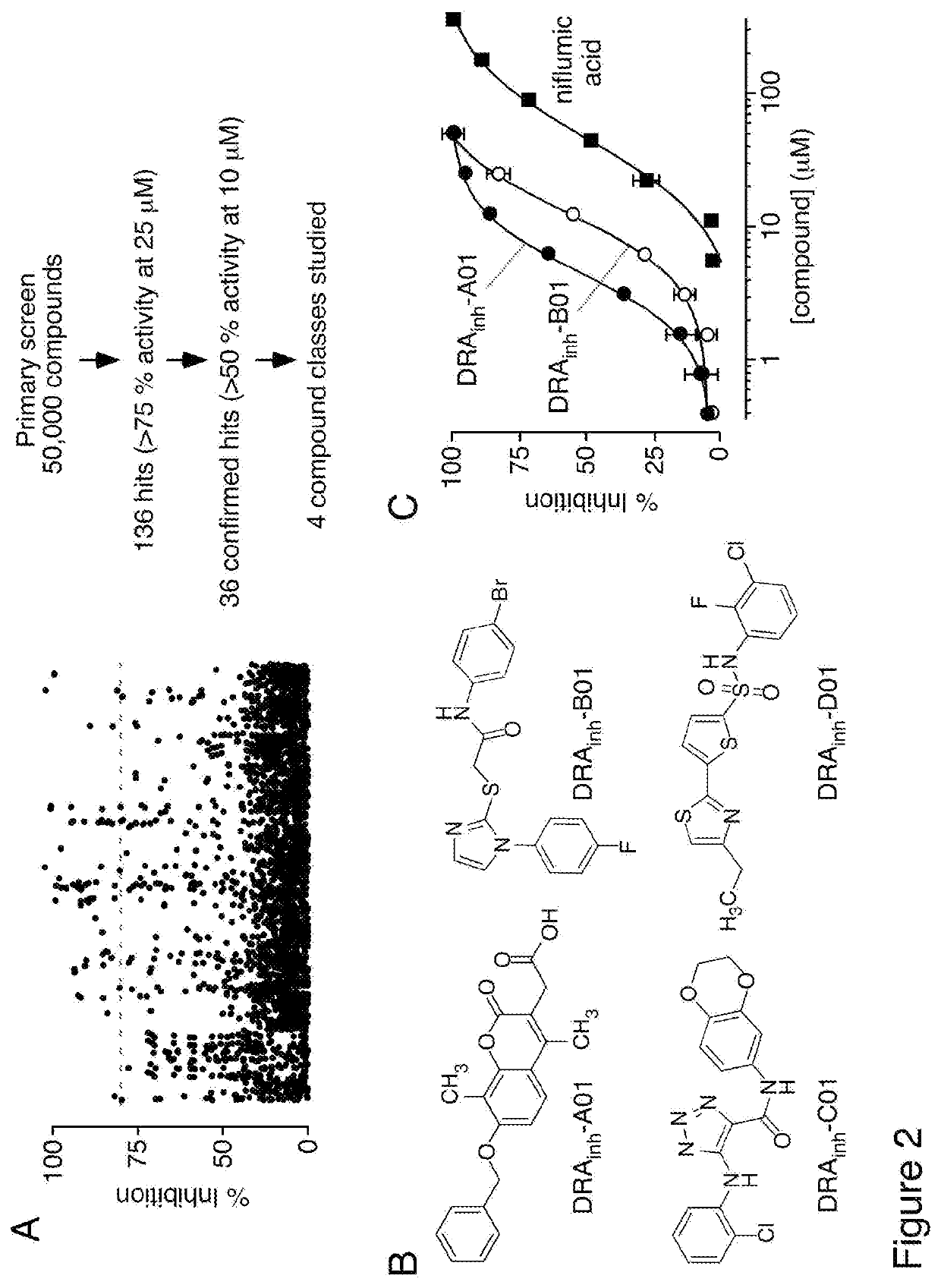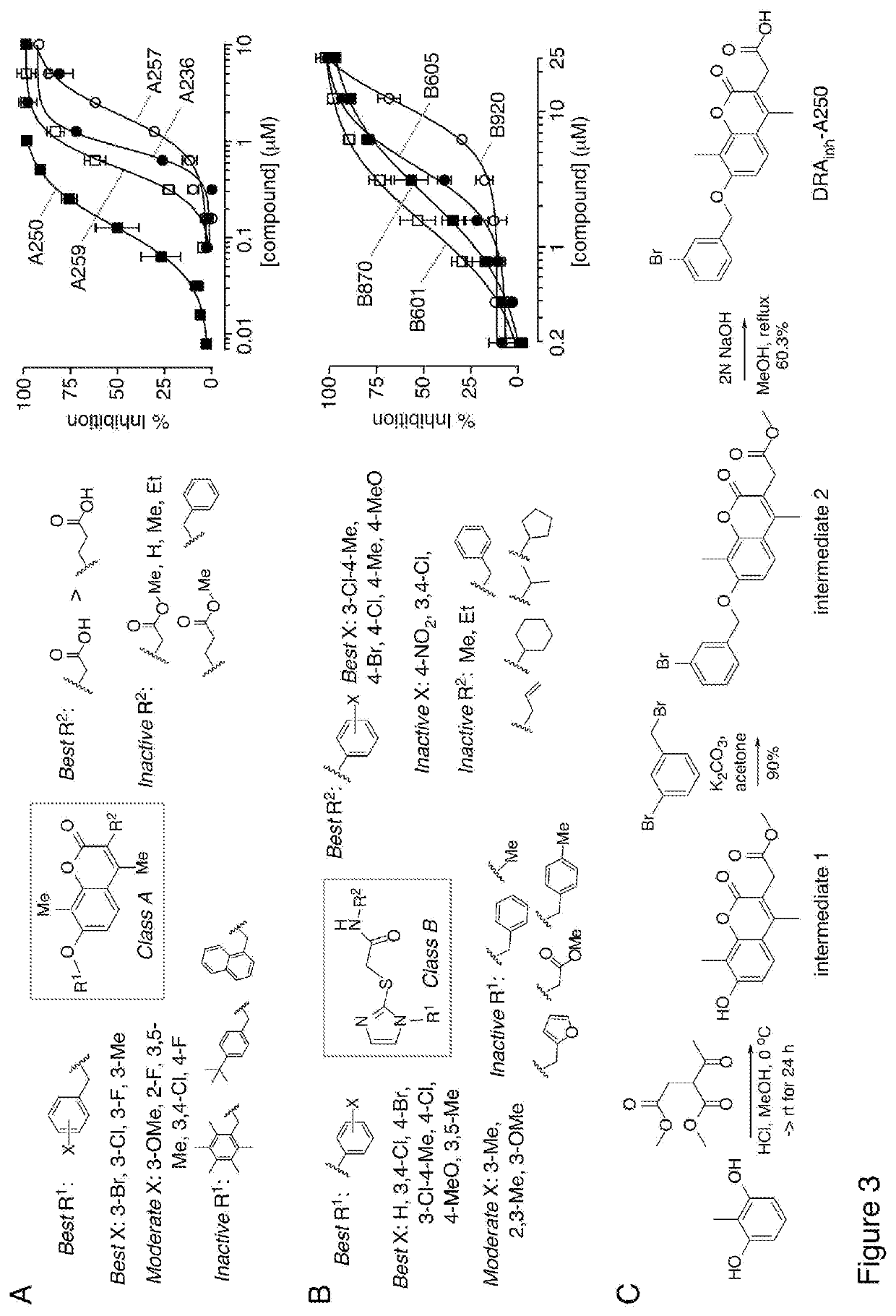Slc26a3 inhibitors and use thereof
a selective inhibitor and anion exchanger technology, applied in the field of selective inhibitors of anion exchangers, can solve the problems of limited clinical efficacy of nhe3 inhibition for constipation and no effective treatment for calcium oxalate, and achieve the effect of inhibiting intestinal fluid absorption and oxalate absorption
- Summary
- Abstract
- Description
- Claims
- Application Information
AI Technical Summary
Benefits of technology
Problems solved by technology
Method used
Image
Examples
example 1
High-Throughput Screen to Identify Slc26A3 Inhibitors
[0182]Screening was done using an FRT cell line stably expressing murine slc26a3 and a halide-sensitive yellow fluorescent protein (FRT-YFP-slc26a3 cells). FRT cells were used because of their low intrinsic permeability to anions that are transported by slc26a3, and because of their good adherence and rapid growth on uncoated plastic. As diagrammed in FIG. 1A, slc26a3-mediated transport was assayed from the kinetics of YFP fluorescence quenching in response to extracellular addition of I− to drive Cl− / I− exchange; transport inhibition reduces the rate of fluorescence decrease. FIG. 1B shows representative fluorescence data from inactive and active compounds tested in screening, together with data from vehicle (DMSO) control, and cells not expressing slc26a3. For screening, the non-selective chloride channel blocker niflumic acid was used as a positive control, which strongly inhibited slc26a3 at 350 μM. The Z′-factor for the slc26...
example 2
Structure-Activity Relationship (SAR) Studies
[0185]Based on potency data and structural considerations, compounds of Class A and Class B were prioritized for further study. A total of 176 commercially available class A analogs and 175 class B analogs were tested. FIGS. 3A and 3B summarize the structural determinants of activity for Class A and Class B compounds (left panels), with concentration-dependence data of selected analogs provided (right panels). Class A compounds are coumarins that are substituted with methyl group on the 4- and 8-positions. Structure-activity analysis showed that the acetic acid moiety at the 3-position (R1) is beneficial for activity, as the corresponding acetate ester was inactive. Replacement of the acetic acid with propanoic acid greatly reduced activity, and non-acid substituents including alkyl and benzyl were inactive. Greatest potency was found for hydroxylation at the 7-position on the coumarin with a benzyl ring (R2), with 3-chloro, 3-fluoro and ...
example 3
Synthesis of Compound A1 (DRAINH-A250)
[0189]For further studies Compound A1 was resynthesized (FIG. 3C) by Pechmann condensation of 2-methylresorcinol with dimethyl acetylsuccinate to yield 7-hydroxycoumarin (intermediate 1), which was further alkylated with 3-bromobenzyl bromide to give coumarin ester (intermediate 2). Hydrolysis of the coumarin ester gave the corresponding 3-acetic acid-coumarin Compound A1 in good yield (FIG. 3C).
[0190]2-methylresorcinol (2.00 g, 16.09 mmol) and dimethyl 2-acetylsuccinate (3.03 g, 16.1 mmol) in absolute methanol (40 mL) were treated with dry HCl at 0° C. The reaction mixture was then stirred at room temperature for 24 h, and the mixture was poured into water. The resulting precipitate was collected by filtration, washed with water, and dried to give an off-white solid (3.02 g, 72% yield) of the desired product (intermediate 1). 1H NMR (300 MHz, MeOH-d4) δ 7.51 (dd, J=8.7, 0.45 Hz, 1H), 6.86 (d, J=8.7 Hz, 1H), 3.728 (s, 2H), 3.720 (s, 3H), 2.41 (s...
PUM
| Property | Measurement | Unit |
|---|---|---|
| time prevalence | aaaaa | aaaaa |
| molecular mass | aaaaa | aaaaa |
| temperature | aaaaa | aaaaa |
Abstract
Description
Claims
Application Information
 Login to View More
Login to View More - R&D
- Intellectual Property
- Life Sciences
- Materials
- Tech Scout
- Unparalleled Data Quality
- Higher Quality Content
- 60% Fewer Hallucinations
Browse by: Latest US Patents, China's latest patents, Technical Efficacy Thesaurus, Application Domain, Technology Topic, Popular Technical Reports.
© 2025 PatSnap. All rights reserved.Legal|Privacy policy|Modern Slavery Act Transparency Statement|Sitemap|About US| Contact US: help@patsnap.com



